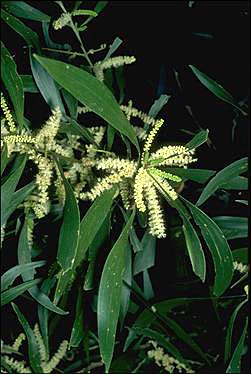Acacia maidenii
| Acacia maidenii | ||||||||||||
|---|---|---|---|---|---|---|---|---|---|---|---|---|

Acacia maidenii , phyllodes and inflorescences |
||||||||||||
| Systematics | ||||||||||||
|
||||||||||||
| Scientific name | ||||||||||||
| Acacia maidenii | ||||||||||||
| F. Garbage. |
Acacia maidenii is a species of the genus Acacia in the subfamily subfamily of the mimosa family (Mimosoideae). It isnativeto the east coast of Australia .
description
Vegetative characteristics
Acacia maidenii grows as an upright or branched, evergreen large shrub or tree that can reach heights of 5 to 20 meters. The dark gray to gray-brown bark is smooth in young trees and becomes deeply fissured with age. The light brown or gray bark of the angular branches is sparsely hairy to balding and has raised lenticels .
The more or less sickle-like curved to sometimes more or less straight, parchment-like to thin leathery phyllodes are very narrow elliptical, elliptical with a length of rarely 7 to usually 10 to 20 centimeters and a width of usually 0.6 to 2.5 centimeters to oblong-obovate. The leaf base and mostly the leaf margins are sparsely hairy. The tip of the leaf is pointed to almost pointed. On the phyllodium there are one to five raised, longitudinal leaf veins , from which many smaller veins branch off. Near the base of the leaf, about 0.6 to 1 centimeter above the 0.1 to 0.25 centimeter long pulvinus , there is an inconspicuous leaf gland .
Generative characteristics
Acacia maidenii blooms from January to June. The 2.5 to 6 centimeters long, spike-like inflorescences contain loosely arranged many flowers. The white or yellowish hairy inflorescence stem is 0.5 to 4 millimeters long.
The pale yellow radial symmetry flowers are usually four-fold with a double flower envelope . The mostly four densely downy hairy sepals are 0.4 to 0.6 millimeters long and fused to three quarters to two thirds of their total length. The mostly four bald petals are 1.2 to 1.7 millimeters long and fused on half to a third of their total length. The only carpel is densely hairy.
The twisted to a loosely spiral ringed, leathery, lengthwise furrowed legumes are glabrous or sparsely hairy. They are approximately cylindrical in shape with a length of 5 to 15 centimeters and a thickness of 0.2 to 0.5 centimeters. The dark brown seeds with a slightly reddish color are oblong to broadly elliptical with a length of 4 to 5.5 millimeters. The aril is cup-shaped.
Occurrence
The natural range of Acacia maidenii is on the coastal regions of eastern Australia. It extends there from Proserpine in Queensland in the north and south to Orbost in Victoria . To the west it reaches the 148th degree of longitude. Acacia maidenii is a neophyte in Argentina , South Africa and the Indian state of Tamil Nadu .
Acacia maidenii grows mainly on more fertile soils which have formed over basalt . Acacia maidenii thrives on the edges of coastal rainforests .
Usage and herbal ingredients
Acacia maidenii is suitable for planting as a street tree .
The researchers Fitzgerald and Sioumis showed in 1965 that the bark contains around 0.6 percent of the hallucinogenic dimethyltryptamine and N-methyltryptamine . This was the first evidence of these substances in an "acacia species". Clark-Lewis and Dainis showed 1967, the extract from the heartwood 7,8,4 - Trihydroxyflavonol , Teracacidin and trans-4-hydroxy-L- pipecolic contains.
Systematics
The first description of Acacia maidenii was made in 1892 by Ferdinand von Mueller in Botanical Centralblatt , Volume 51, page 398. A synonym for Acacia maidenii F.Muell. is Racosperma maidenii (F.Muell.) Pedley . The specific epithet maidenii honors the British-Australian botanist Joseph Maiden .
The species closely related to Acacia maidenii include Acacia floribunda , the long-leaved acacia ( Acacia longifolia ) and Acacia longissima , from which it can be distinguished by the conspicuous lenticels of the branch bark and the yellowish trichomes of the inflorescence shafts.
Web links
swell
- Flora of Australia , Volumes 11, 2001) and 12, 1998: Acacia maidenii. In: Flora of Australia Online. Anbg.gov.au, accessed on March 2, 2014 (English).
- (last edited May PG Kodela: Acacia maidenii. In: Flora of New South Wales Online. plantnet.rbgsyd.nsw.gov.au, 2012, accessed on March 2, 2014 (English).
Individual evidence
- ↑ a b c d e f g h Acacia maidenii. In: Flora of Australia Online. Anbg.gov.au, accessed on March 2, 2014 (English).
- ↑ a b c d e f g Acacia maidenii. In: Flora of New South Wales Online. plantnet.rbgsyd.nsw.gov.au, accessed on March 2, 2014 .
- ↑ a b Data sheet at International Legume Database Information Service = ILDIS - LegumeWeb - World Database of Legumes , Version 10.38 from July 20, 2010.
- ↑ Metro Trees ( Memento from January 25, 2014 in the Internet Archive )
- ↑ JS Fitzgerald, AA Sioumis: Alkaloids of the Australian Leguminosae. V. The occurrence of methylated tryptamines in Acacia maidenii F. Muell . In: Australian Journal of Chemistry . tape 18 , no. 3 , 1965, p. 433-434 (English, csiro.au [PDF]).
- ^ JW Clark-Lewis, I. Dainis: Flavan derivatives. XIX. Teracacidin and isoteracacidin from Acacia obtusifolia and Acacia maidenii heartwoods; Phenolic hydroxylation patterns of heartwood flavonoids characteristic of sections and subsections of the genus Acacia . In: Australian Journal of Chemistry . tape 20 , no. 10 , 1967, p. 2191-2198 (English, abstract ).
- ↑ Acacia maidenii at Tropicos.org. Missouri Botanical Garden, St. Louis, accessed March 2, 2014.
